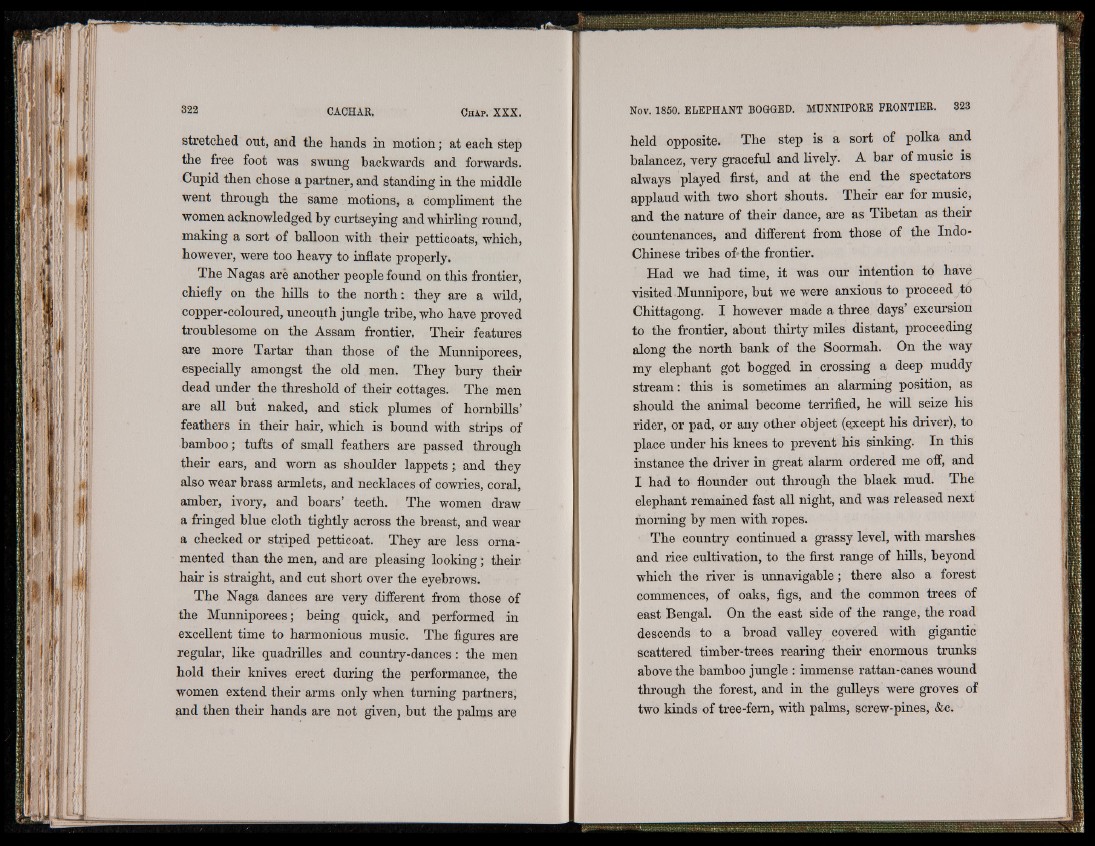
stretched out, and the hands in motion; at each step
the free foot was swung backwards and forwards.
Cupid then chose a partner, and standing in the middle
went through the same motions, a compliment the
women acknowledged by curtseying and whirling round,
making a sort of balloon with their petticoats, which,
however, were too heavy to inflate properly.
The Nagas are another people found on this frontier,
chiefly on the hills to the n o rth : they are a wild,
copper-coloured, uncouth jungle tribe, who have proved
troublesome on the Assam frontier, Their features
are more Tartar than those of the Munniporees,
especially amongst the old men. They bury their
dead under the threshold of their cottages. The men
are all but naked, and stick plumes of hombills’
feathers in their hair, which is bound with strips of
bamboo; tufts of small feathers are passed through
their ears, and worn as shoulder lappets; and they
also wear brass armlets, and necklaces of cowries, coral,
amber, ivory, and boars’ teeth. The women draw
a fringed blue cloth tightly across the breast, and wear
a checked or striped petticoat. They are less ornamented
than the men, and are pleasing looking; their
hair is straight, and cut short over the eyebrows.
The Naga dances are very different from those of
the Munniporees; being quick, and performed in
excellent time to harmonious music. The figures are
regular, like quadrilles and country-dances: the men
hold their knives erect during the performance, the
women extend their arms only when turning partners,
and then their hands are not given, but the palms are
held opposite. The step is a sort of polka and
balancez, very graceful and lively. A bar of music is
always played first, and at the end the spectators
applaud with two short shouts. Their ear for music,
and the nature of their dance, are as Tibetan as their
countenances, and different from those of the Indo-
Chinese tribes of* the frontier.
Had we had time, it was our intention to have
visited Munnipore, but we were anxious to proceed to
Chittagong. I however made a three days’ excursion
to the frontier, about thirty miles distant, proceeding
along the north bank of the Soormah. On the way
my elephant got bogged in crossing a deep muddy
stream: this is sometimes an alarming position, as
should the animal become terrified, he will seize his
rider, or pad, or any other object (ejxcept his driver), to
place under his knees to prevent his sinking. In this
instance the driver in great alarm ordered me off, and
I had to flounder out through the black mud. The
elephant remained fast all night, and was released next
morning by men with ropes.
The country continued a grassy level, with marshes
and rice cultivation, to the first range of hills, beyond
which the river is unnavigable; there also a forest
commences, of oaks, figs, and the common trees of
east Bengal. On the east side of the range, the road
descends to a broad valley covered with gigantic
scattered timber-trees rearing their enormous trunks
above the bamboo jungle : immense rattan-canes wound
through the forest, and in the gulleys were groves of
two kinds of tree-fern, with palms, screw-pines, &c.